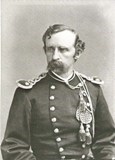|
Several frontier regiments had been created at the end of the Civil War, including the 7th Cavalry in 1866. At its peak, the 7th Cavalry numbered some 850 men. Over 40% of that number were foreign born, with the majority born in Ireland or the German states. The 7th Cavalry was known for its esprit de corps (sense of unity, camaraderie, and shared purpose). The jaunty Irish tune "Garryowen" was its official marching song. U.S. 7th CavalrySome Participants of the Battle of the Little Bighorn
Lt. Colonel George Armstrong CusterAfter his early education, George Armstrong Custer became a school teacher; soon he was accepted as a cadet at the United States Military Academy in West Point, New York and the rest is history. |
Last updated: September 22, 2025
